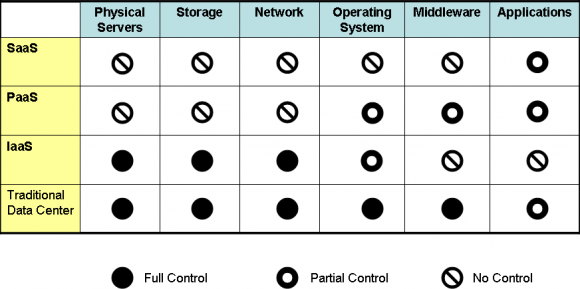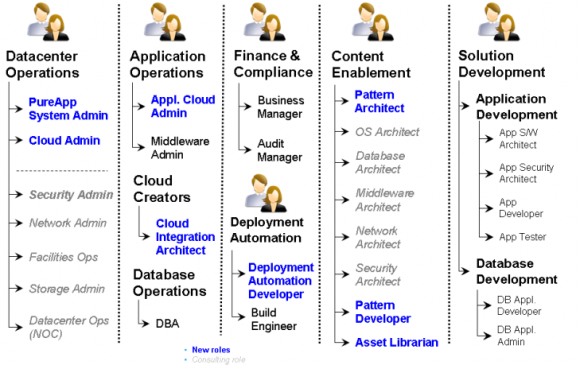The cloud is forcing business IT operations and staff roles to evolve. Learn more about the changes and new opportunities the cloud is bringing to IT
by Ashok K. Iyengar
Editor’s Note: This article is excerpted from chapter 7 of IBM Cloud Platform Primer, by Ashok K. Iyengar.
The biggest changes that cloud computing brings to an enterprise are changes in mindset and operational transformation. While some of these changes are abstract, there are very concrete things that IT organizations can and should do to take full advantage of the cloud environment. From redefining roles to taking on new responsibilities, this chapter discusses the various operational and organizational transformations afoot in large IT organizations.
Even signing up to be a user of public cloud services, whether those services are infrastructure or software, requires a change in the IT thought process. By the end of this chapter, it should be apparent that to operate in this new environment you need to be more of a generalist than a specialist.
A Different Approach to IT Operations
IT staff who manage traditional data centers have far more control than those who manage cloud environments. The nature of cloud computing allows non-IT staff to do more, so the traditional install-and-maintain paradigm has given way to deploy and monitor. As the move to service-based IT continues, the knowledge, skills, and abilities of many of the IT roles are very quickly being transformed.
As Figure 1 shows, in a traditional data center IT staff has full control over most components and tasks. But as you move to “as a service” environments, we see the IT teams have less control of and influence over how things are done. While that might make IT operations teams uneasy, it bodes well for the developer community because they are no longer at the mercy of the IT staff and can thus accelerate the speed of development and deployment of software solutions.
Figure 1: Spheres of influence by IT departments
This shift really means that the roles, responsibilities, and skill sets are changing in the IT landscape. For example, systems administrators now have the opportunity to become cloud administrators, service managers can look ahead to becoming cloud service managers, enterprise architects are becoming cloud architects, and even the ever-present computer consultant can add new skills to his or her repertoire and become a cloud consultant. So, there is something new for everyone in the cloud space.
New Opportunities in the Cloud
What do IT professionals have to look forward to in moving to the cloud? The first thing to realize is that systems have become smarter, simpler, and more accessible, and consequently the need is for more generalists and fewer specialists in the cloud-based IT organization. The expert integrated systems on which most cloud environments run are forcing organizations to become less compartmentalized and much more integrated.
These cloud systems are also forcing a change in skill sets. One has to think about transient resources more than permanent resources. The promise of making it easier to implement virtualized environments also means that re-provisioning the same resources becomes easier. The result is that environments have shorter lifetimes. People will have to become good at learning various abstraction layers.
Some of the new roles and the responsibilities that come with them are discussed below. These roles are directly responsible for interacting with cloud systems. Other roles are more consultative in nature and are considered secondary roles. Figure 2 captures the suggested roles for IT departments that are considering implementing cloud solutions.
Figure 2: Suggested roles for IT departments deploying cloud solutions
- Cloud administrator: The cloud administrator role is responsible for configuring and managing the physical cloud. That responsibility encompasses all assets related to the cloud, such as creating cloud groups to provide isolation, creating IP groups when required, monitoring resource utilization, and most important, adjusting assigned resources based on the needs and demands of the cloud users.
- Cloud architect: It is imperative that enterprise architects now understand IaaS, PaaS, and SaaS. Every cloud computing architecture will touch one or more of those services. Knowing whether to recommend a public cloud or a private cloud and whether to make use of software as a service for lower environments are some of the nuances that cloud architects must be familiar with. A cloud architect will also be asked to provide leadership in convincing customers on the adoption and use of cloud computing.
- Cloud consultant: The things that drive cloud computing, such as rapid application development and continuous delivery or DevOps, new scripting languages, and new APIs, including Representational State Transfer (REST) and mobile APIs, are some of the competencies a cloud consultant needs to develop. Whether it is automating deployments or pushing applications to a public cloud platform, this role forces one to be a generalist and agile.
- Cloud developer: A cloud developer has a narrower scope than does a cloud consultant. He or she would create applications using languages such as Node.js and use Python or shell scripting to facilitate application deployment. The cloud developer would know how to grab resources in the cloud when needed and make it a point to release them or de-allocate them they are no longer needed. One has to understand the intricacies of working in a shared environment and why security is so important.
- Cloud integration architect: Developing integration architecture and providing integration solution guidance is the main role of the cloud integration architect. Whether it’s integration of back-end systems in the data center with the public cloud or finding the right architecture to connect an on-premises cloud with off-premises services, the cloud integration architect would be familiar with all types of cloud, especially hybrid cloud solutions. This role would also need to be aware of cloud orchestration and related tools.
Other roles are not new, but their job descriptions have expanded to include cloud-related responsibilities.
- Systems administrator: As with any physical server, the systems administrator will have to own the physical cloud system in the case of a private or on-premises cloud. Keeping the system up, monitoring it, reporting on it, and providing security credentials to users would be among the systems administrator’s tasks. If the organization is using a public cloud or off-premises cloud, the additional responsibilities would be minimal and would entail monitoring the availability of the off-premises cloud, requesting user and group access, and requesting new software.
- Network administrator: The job of planning, design, assigning, deploying, and maintaining the enterprise network continues as usual, but now the job would span one or more cloud infrastructures. Network administrators would have to work with the cloud administrator to agree on the allocation of network resources and provide the necessary VLANs and IP groups to create clouds and ensure network compliance within the enterprise.
- Security administrator: One area that garners a lot of attention is security. Clients are afraid that putting things on the cloud would open a window into all their business secrets and private data. Security administrators are heavily consulted when standing up a cloud environment to enforce corporate security compliance and appease corporate executives that there are no security holes that would allow unauthorized entry into the corporate IT domain from the cloud. While customers love the idea of self-service, security administrators have to constantly manage users and groups and review the necessary authorization to the cloud.


























 More than ever, there is a demand for IT to deliver innovation. Your IBM i has been an essential part of your business operations for years. However, your organization may struggle to maintain the current system and implement new projects. The thousands of customers we've worked with and surveyed state that expectations regarding the digital footprint and vision of the company are not aligned with the current IT environment.
More than ever, there is a demand for IT to deliver innovation. Your IBM i has been an essential part of your business operations for years. However, your organization may struggle to maintain the current system and implement new projects. The thousands of customers we've worked with and surveyed state that expectations regarding the digital footprint and vision of the company are not aligned with the current IT environment. TRY the one package that solves all your document design and printing challenges on all your platforms. Produce bar code labels, electronic forms, ad hoc reports, and RFID tags – without programming! MarkMagic is the only document design and print solution that combines report writing, WYSIWYG label and forms design, and conditional printing in one integrated product. Make sure your data survives when catastrophe hits. Request your trial now! Request Now.
TRY the one package that solves all your document design and printing challenges on all your platforms. Produce bar code labels, electronic forms, ad hoc reports, and RFID tags – without programming! MarkMagic is the only document design and print solution that combines report writing, WYSIWYG label and forms design, and conditional printing in one integrated product. Make sure your data survives when catastrophe hits. Request your trial now! Request Now. Forms of ransomware has been around for over 30 years, and with more and more organizations suffering attacks each year, it continues to endure. What has made ransomware such a durable threat and what is the best way to combat it? In order to prevent ransomware, organizations must first understand how it works.
Forms of ransomware has been around for over 30 years, and with more and more organizations suffering attacks each year, it continues to endure. What has made ransomware such a durable threat and what is the best way to combat it? In order to prevent ransomware, organizations must first understand how it works. Disaster protection is vital to every business. Yet, it often consists of patched together procedures that are prone to error. From automatic backups to data encryption to media management, Robot automates the routine (yet often complex) tasks of iSeries backup and recovery, saving you time and money and making the process safer and more reliable. Automate your backups with the Robot Backup and Recovery Solution. Key features include:
Disaster protection is vital to every business. Yet, it often consists of patched together procedures that are prone to error. From automatic backups to data encryption to media management, Robot automates the routine (yet often complex) tasks of iSeries backup and recovery, saving you time and money and making the process safer and more reliable. Automate your backups with the Robot Backup and Recovery Solution. Key features include: Business users want new applications now. Market and regulatory pressures require faster application updates and delivery into production. Your IBM i developers may be approaching retirement, and you see no sure way to fill their positions with experienced developers. In addition, you may be caught between maintaining your existing applications and the uncertainty of moving to something new.
Business users want new applications now. Market and regulatory pressures require faster application updates and delivery into production. Your IBM i developers may be approaching retirement, and you see no sure way to fill their positions with experienced developers. In addition, you may be caught between maintaining your existing applications and the uncertainty of moving to something new. IT managers hoping to find new IBM i talent are discovering that the pool of experienced RPG programmers and operators or administrators with intimate knowledge of the operating system and the applications that run on it is small. This begs the question: How will you manage the platform that supports such a big part of your business? This guide offers strategies and software suggestions to help you plan IT staffing and resources and smooth the transition after your AS/400 talent retires. Read on to learn:
IT managers hoping to find new IBM i talent are discovering that the pool of experienced RPG programmers and operators or administrators with intimate knowledge of the operating system and the applications that run on it is small. This begs the question: How will you manage the platform that supports such a big part of your business? This guide offers strategies and software suggestions to help you plan IT staffing and resources and smooth the transition after your AS/400 talent retires. Read on to learn:
LATEST COMMENTS
MC Press Online